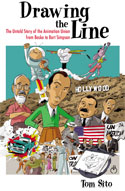|
Anime Industry problems March 4th, 2009 |
|
From the March 4th edition of JAPAN TIMES online.
Future of 'anime' industry in doubt
Money, success elude; outsourcing, piracy abound
By ALEX MARTIN
Staff writer
After graduating from Tokyo Animator College, Yuko Matsui began working at a midscale animation production agency.
Two years later, she earns roughly ¥80,000 a month, averaging 10 hours a day doing the grunt work of filling out "in-between cels," drawings on transparent sheets used between key scenes to help create the illusion of motion.
Although she lives with her parents, she can't save any money and has given up on paying her national pension fees. Still, the 22-year-old apprentice considers herself better off than some of her peers who say they have to endure frequent all-nighters with few days off.
"There were seven others I knew who graduated with me at the same time, but three of them have already given up and quit," she said.
Matsui's story is typical of what many aspiring animators must face in a trade where only the best survive in a shrinking job market. And it's not just the employees who are hurting.
The deepening recession and rapid shift in the overall landscape surrounding the industry have caused many to fear for the future of one of the nation's most prized cultural exports.
"The global fan base for Japanese 'anime' is increasing, but with the old business model crumbling it isn't translating into profits," said Yasuo Yamaguchi, executive director of the Association of Japanese Animations.
For the past decade, the industry has been hammering out average annual sales of ¥200 billion in what experts described as an "animation bubble."
Yamaguchi predicted, however, that the industry's proceeds for fiscal 2008 ? which have yet to be calculated ? would be lower than 2007, when total sales dropped almost ¥20 billion from 2006, a record high year, according to AJA statistics.
"The financial crisis is forcing sponsors to cut down on television advertisement fees, and this in turn is shrinking the budgets for animations, pressuring everyone involved in the production," Yamaguchi said.
"I think we'll see a major decrease in the number of anime programs broadcast. Agencies dependent on television as a primary financial source will need to search for alternatives."
Besides the gloomy economy, the overwhelmingly adult content of recent television animation ? many featuring violent or highly sexual material and broadcast during late-night hours ? has played a part in limiting the audience and making both marketing and merchandising of anime-related products difficult.
Yoshihiko Noda, director of the media content division for ad agency Asatsu-DK, buys TV time slots for popular family programs such as "Doraemon" and "Crayon Shin-chan." He said these trends were a relatively recent phenomenon.
"The demographics of anime fans began shifting seven to eight years ago. Those who grew up watching cartoons became older, and began craving more 'otaku' (geek) and adult content," Noda said, noting such animation is mainly produced for DVD sales, with the late-night shows ? usually consisting of only 13 episodes ? used as bait to draw viewers into buying the full DVD set that comes with increased content and special features.
This lack of mainstream acceptability in anime content, combined with expensive title licenses and the exploding popularity of video-sharing sites, has helped erode the industry's distribution market in the West.
"Anime-related profits in the United States, especially DVDs, are dwindling," said Keisuke Iwata, director of animation channel AT-X.
"Thanks to megahits such as 'Evangelion' and 'Pokemon,' Japanese animation has fared well in the past. But it has already maxed out as an export industry," Iwata explained, adding that besides the lack of big-name titles and a decrease in overseas airplay in recent years, the greatest obstacle lies in the illegal Internet sites that provide free content.
"These sites upload programs almost immediately after they are broadcast in Japan," accompanied with "fan subs" ? English subtitles translated by fans," Iwata said. "This is causing a very big dent in sales."
To counter the trend, TV Tokyo tied up with popular San Francisco-based animation-sharing site Crunchyroll in January, offering some of TV Tokyo's popular titles in advertisement-free, high-quality format with subtitles for a monthly fee of $6.95.
Yukio Kawasaki, manager of TV Tokyo's animation business department, said the move was an attempt to create a legitimate distribution channel between animation producers and overseas fans, as well as a way to send out a message.
"Animation isn't free. It's the product of hard work and a lot of money, and we cannot continue producing quality content without the financial help from fans," Kawasaki said, explaining that if the strategy succeeds, they could expand by selling DVDs and comic books on the site, "like Amazon.com," and establish a valid business model.
Kawasaki said they have signed up more than 10,000 fee-paying members since the tieup began Jan. 8 and hope to reach 50,000 by the end of this year.
"We are seriously concerned that the industry will not survive if things go on like this," he said, acknowledging that whether their new plan succeeds or not, the structural issue undermining the industry will still exist.
"You've got to really love animation to be in this trade," said Takeo Ide, chief animator for the popular television series "One Piece."
Ide recalled how he used to make ¥70,000 a month in his rookie years, sharing a cheap apartment to get by before being assigned to draw the more pricey key frames ? drawings that define the starting and ending points of movements.
Ide's is a success story in an occupation that, according to a study conducted by the Japan Council of Performers' Organization, has an appalling turnover rate of 80 percent.
The study revealed that a single cel on average earns animators a meager ¥186.9. Considering how a grunt worker has to fill in 500 in-between cels per month for a television animation series, this means a monthly wage of ¥94,000 at best ? for an average of 250 hours of work ? until an artist gets to handle key frames or storyboards.
With an estimated 90 percent of in-betweens being outsourced overseas ? a result of the industry trying to squeeze out more content than it can from domestic hands ? there are also concerns that opportunities to nurture future generations of quality animators are being lost.
"Drawing in-between cels is hard work and it sure doesn't pay much, but it's still an important skill that every animator should learn," said Masayuki Kawachi, president of the All-Toei Labor Union.
Kawachi, who handles special effects at Toei Animation Studio, said that in the current situation, most of such work is done in countries like China and the Philippines.
"And with the recession eating away at production fees and forcing agencies to downsize or go bankrupt, young and aspiring animators can't find places to work," Kawachi said.
Reflecting such times, animation studio Gonzo, a well-known name in the industry, recently confirmed it plans to pare the number of contracted creators from 130 to 30 over the next five years.
The Japan Fair Trade Commission on Jan. 23 released a report on the state of the animation industry, listing several major concerns.
One is the lack of copyrights attributed to production agencies ? copyrights are divvied up among sponsors, a system widely criticized for robbing the actual creators of any secondary-use benefits, not to mention motivation.
Another is the popular practice of commissioning and recommissioning production work to smaller agencies that often leads to shady transactions.
Kawachi said such issues ? not new to the industry ? have largely been ignored in the past but will need to be dealt with one way or another if the industry hopes to remain the dominant force behind the global animation market.
In 2006, Kawachi's union, joined by the Federation of Cinema and Theatrical Workers Union in Japan, presented the culture ministry with a proposal on restructuring the animation industry, outlining main issues and suggesting solutions. Kawachi said they received no response from the government.
Yamaguchi of AJA, who also lectures on animation literacy at Nihon University's law school, predicts that in the end, quality, not quantity, will come to be emphasized.
"When we look at viewer ratings of animated television programs, we notice that the top slot is always dominated by 'Sazae-san,' the only program that is still produced using the traditional hand-drawn method," he said, adding that this trend could also be seen in last year's ¥15 billion-grossing hit "Ponyo on the Cliff by the Sea," a hand-drawn movie produced by Hayao Miyazaki's Studio Ghibli.
"In this age of mass production, when most animation is digitized, we need to consider the implications of such data," Yamaguchi said.
"I think we need to think, philosophically, about what our users really want."
Thank you Karl Cohen for making me aware of this article. For the complete story check out the Japan Times Online.

|




